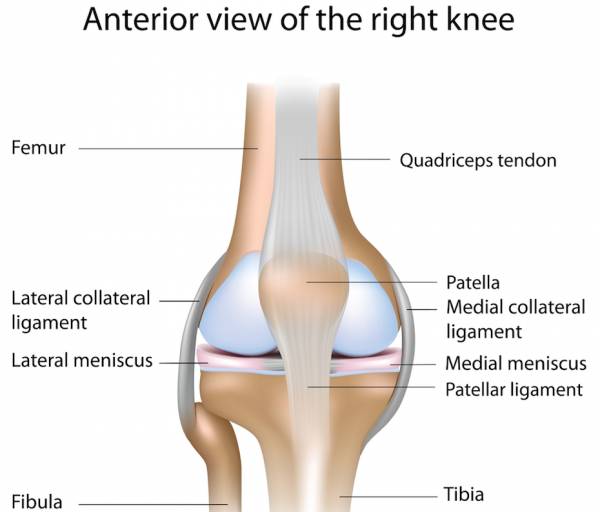Knee aches and pains are expected in an athlete’s training, but how does an athlete or parent know if the pain is a normal part of conditioning or if it is something more? This article will explain Osgood-Schlatter disease and its cause, discuss its symptoms and diagnosis, and offer various at-home treatments to alleviate Osgood-Schlatter knee pain.
What Is Osgood-Schlatter?
Fortunately, the medical diagnosis of Osgood-Schlatter sounds much worse than it is. Although termed a disease, Osgood-Schlatter is actually an overuse injury primarily attributed to youth athletes. The medical term was first introduced in 1903, when U.S. orthopedic surgeon Robert Osgood and Swiss surgeon Carl Schlatter concurrently diagnosed this common cause of adolescent knee pain.
In medical terms, Osgood-Schlatter disease is an inflammation of the bone, cartilage, and/or tendon at the top of the shinbone (tibia). The tendon from the kneecap (patella) attaches downward to the growth plate on the front of the shinbone (tibia). The thigh muscles (quadriceps) attach to and pull on the patella, with a resultant pull on the patellar tendon. The patellar tendon then pulls on the tibia in the area of the growth plate.
“In medical terms, Osgood-Schlatter disease is an inflammation of the bone, cartilage, and/or tendon at the top of the shinbone (tibia).”
This repeated stress can cause the tendon to pull away from the shinbone, resulting in the pain and swelling associated with Osgood-Schlatter disease. In some cases, the body may attempt to compensate by trying to close that gap with new bone growth, which can result in a bony lump at that spot. A common misconception is that bones grow from the center outward, when, in actuality, the bones grow at the ends near the growth plate. Since growth areas are made of cartilage, and are not as strong as bone, high levels of stress or impact on those areas, as well as repetitive motions, can cause the growth plates to hurt and swell.
Who It Affects
Osgood-Schlatter disease is more common in boys than girls and usually affects adolescent athletes between the ages of ten and fifteen. In his article, Osgood-Schlatter Disease, Dr. J. Andy Sullivan, Clinical Professor of Pediatric Orthopedics at the University of Oklahoma College of Medicine, stated that the disease affects approximately 21% of athletic adolescents. Interestingly, while most adolescents only experience Osgood-Schlatter in one knee, some youth experience pain in both knees. It is still unknown, though, why some adolescents experience Osgood-Schlatter and some do not.

Symptoms
There are certain symptoms and activities associated with Osgood-Schlatter, although the severity of the pain varies with each person. Knee pain may be accompanied by swelling and is usually associated with high-impact activities such as running and jumping. Knee pain can last for several weeks or several months, but may continue to recur, until growth has stopped.
“Osgood-Schlatter disease is more common in boys than girls and usually affects adolescent athletes between the ages of ten and fifteen.”
It is rare for Osgood-Schlatter pain to persist after growth has stopped. Let’s go back to our aforementioned description of bone growth. When the cartilage of the growth plate stops growing, it fills in with bone. When this happens, the bone, rather than the cartilage, is stressed, so the pain associated with the stress of the cartilage goes away.
In diagnosing Osgood-Schlatter disease, Dr. Sullivan explains that the medical examination is very specific and will include:
- Observation of tibial swelling and tenderness
- Observation of erythema of the tibial tuberosity
- Observation of enlargement of the tibial tubercle
- Tenderness to palpation over the tibial tuberosity at the site of patellar insertion
- Observation of full range of motion of the knee
- Observation of hamstring tightness
- Observation of quadriceps atrophy
- Observation of no effusion or meniscal signs
- Observation of knee stability/instability
- Reproducing knee pain by direct pressure and jumping
- Reproducing knee pain with resisted knee extension
- Neurovascular examination
- Normal findings in the hip and ankle joints
Treatment
Once an athlete has been medically diagnosed with Osgood-Schlatter, the Mayo Clinic recommends the following at-home treatments to help alleviate the pain:
- Rest the joint. Limit the time spent doing activities that aggravate the condition, such as kneeling, jumping, and running
- Ice the affected area to reduce pain and swelling.
- Stretch the leg muscles, especially the quadriceps.
- Protect the affected knee by wearing a kneepad.
- Use a patellar tendon strap that fits around the leg just below the kneecap. This may help stabilise the kneecap tendon during activities, and distribute some of the force away from the shinbone
- Cross-train. Encourage the athlete to participate in activities that don’t involve jumping or running, such as cycling or swimming, until symptoms subside.
Never Fear
While knee pain in adolescent athletes is a common training complaint, pain that does not resolve should not be ignored. Through knowledge and understanding of this common adolescent overuse injury, coaches, trainers, parents, and athletes can help prevent, as well as mitigate, the pain of Osgood-Schlatter.
More on youth and health:
References:
1. “Osgood-Schlatter Disease.” J Andy Sullivan, MD; Chief Editor: Craig C Young, MD and others. Updated: July 15, 2014. Accessed April 19, 2015.
2. “Osgood-Schlatter Disease.” Reviewed by: Mary L. Gavin, MD. January 2014. Accessed April 19, 2015.
3. “Osgood-Schlatter Disease.” Mayo Clinic Staff. 2015 Mayo Foundation for Medical Education and Research. Accessed April 19, 2015.
4. “Patient Johns Hopkins Sports Medicine Guide to Osgood-Schlatter Disease.” Edward G. McFarland, M.D., Andrew Cosgarea, M.D. Accessed 19 April, 2015.
Photos courtey of Shutterstock.






